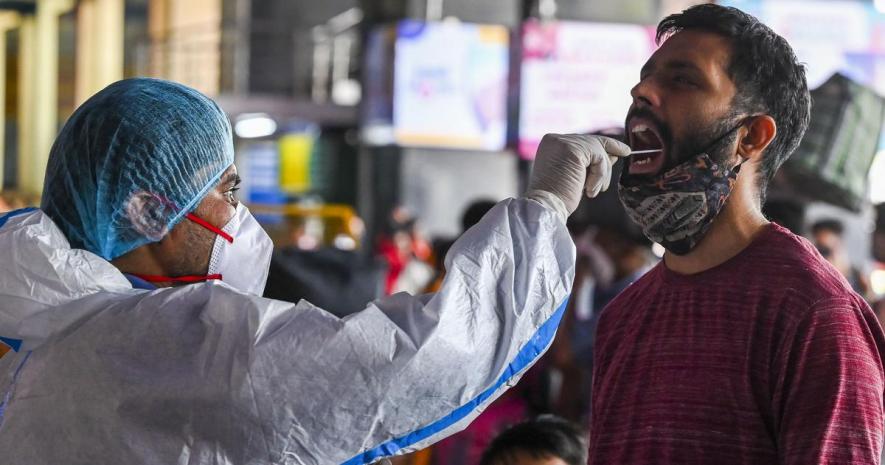India’s Second COVID-19 Wave: 'Government Shortsightedness a Major Factor', Says Expert

Image Courtesy: scroll.in
India is now the second-worst affected country from COVID-19 with a rampant second wave claiming 1,027 lives on Tuesday. The number of recorded cases have consistently been over the 1.5 lakh mark for several consecutive days with 1,84,372 cases recorded on April 13. Hospitals are flooded with patients and lockdowns and other measures are in place in several states.
Towards the end of February this year, India was relatively comfortable, with daily cases below 20,000 a day. However, a second wave, that began to gain momentum from mid-March has jolted the country.
AIIMS (All India Institute Of Medical Sciences) director Randeep Guleria recently elaborated upon certain reasons why the country found itself in the present situation. A sense of apathy in taking appropriate measures and new mutant strains of the virus were the main reasons why COVID-19 is running amok, he said.
Newsclick reached out to Satyajit Rath, immunologist and an adjunct faculty at IISER Pune, to understand what went wrong on India’s part, on the mutant strains of the virus and on what needs to be done going forward.
Factors Which Led to the Current Crisis:
“There are clearly a number of possible contributing factors. Firstly, most widespread epidemics are quite likely to behave and spread like this; local outbreaks that ebb and flow based on the coincident convergence of local factors. Secondly, as is expected at such a stage in any viral disease epidemic, 'variant' virus strains have begun to emerge that have 'advantages' over the original strains in terms of how efficiently they spread, and this is also likely to be a factor in the present 'surge'. Although, it is hard to say just how much their role is in the absence of any proper evidence (a failure that, like many others, must be laid at the door of the government).”
The Human Follies at Play:
“There is indeed a 'distancing fatigue' countrywide, which has quite likely contributed to increasing the pace of the infection spread. However, the government's own approach to the pandemic has been a major contributor to both, this 'distancing fatigue' as well as to 'COVID complacency'. The government has been short-sighted and stingy in the context of a lack of durable capacity building, and in terms of addressing livelihood-related miseries resulting from the pandemic-directed policies adopted; both issues that have at least compounded this 'distancing fatigue'. Yet, the government has focused on the periodic declarations of triumphalist victories over 'corona', lending weight to complacency as well.”
The Impact of Mutant Strains:
“It is quite plausible that 'variants' that spread more efficiently are likely to be a factor in the present 'surge'. However, India's strategy and execution for collecting well-documented clinical samples and sequencing the virus in them on a large enough scale from across the country, from various categories of people and over large periods of time, has not been a stellar success so far. Transparency about such plans and the resultant evidence has also been conspicuously lacking. As a result, we quite simply do not know to what extent variants are responsible for the present situation, even though we are all guessing that they are contributing to some extent.”
On Measures Like Night Curfews and Lockdowns, and the Kumbh Anomaly:
“Of course it reflects a particular attitude on the part of the government. As I noted above, governments in India – both at the Centre and in states – have been most consistent in treating the pandemic as a short-term crisis that will go away, without any structural investments from the government; 'if only the people would behave well and grit their collective teeth and tighten their belts and bear the misery for a while', so to say. This has meant that most government responses have been 'on-again, off-again'; short-term ones such as the ones you mention. The state attitude of blaming the people has also meant that this public health situation has been treated, more than warranted, as a 'law-and-order' problem, over and over again. It is given this background that we should understand the more frankly sectarian examples such as the Kumbh Mela (not simply the permission given to it but also the statements of political leadership about it).”
What Can be Done Now?
“Over the very short term what we need as state policy for this particular 'surge' is, of course, massive state intervention in creating decentralised tertiary health care facilities for ill people to access, coupled with a far more robust provision of livelihood support for the inevitable miseries when law-and-order-based distancing policies are put in place. However, it is also necessary to abandon the head-in-the-sand short-term perspective and plan for the intermediate and the long term; it is a lack of that planning last year that has brought us to where we are today.”
Get the latest reports & analysis with people's perspective on Protests, movements & deep analytical videos, discussions of the current affairs in your Telegram app. Subscribe to NewsClick's Telegram channel & get Real-Time updates on stories, as they get published on our website.
























